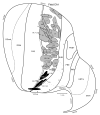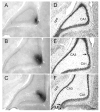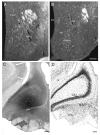Analysis of direct hippocampal cortical field CA1 axonal projections to diencephalon in the rat
- PMID: 16680763
- PMCID: PMC2570652
- DOI: 10.1002/cne.20985
Analysis of direct hippocampal cortical field CA1 axonal projections to diencephalon in the rat
Abstract
The hippocampal formation is generally considered essential for processing episodic memory. However, the structural organization of hippocampal afferent and efferent axonal connections is still not completely understood, although such information is critical to support functional hypotheses. The full extent of axonal projections from field CA1 to the interbrain (diencephalon) is analyzed here with the Phaseolus vulgaris-leucoagglutinin (PHAL) method. The ventral pole of field CA1 establishes direct pathways to, and terminal fields within, the anterior hypothalamic nucleus, ventromedial hypothalamic nucleus, lateral hypothalamic and lateral preoptic areas, medial preoptic area, and certain other hypothalamic regions, as well as particular midline thalamic nuclei. These results suggest that hippocampal field CA1 modulates motivated or goal-directed behaviors, and physiological responses, associated with the targeted hypothalamic neuron populations.
Copyright 2006 Wiley-Liss, Inc.
Figures







References
-
- Albers HE, Rawls S. Coordination of hamster lordosis and flank marking behavior: role of arginine vasopressin within the medial preoptic-anterior hypothalamus. Brain Res Bull. 1989;23:105–109. - PubMed
-
- Allen GV, Hopkins DA. Mamillary body in the rat: topography and synaptology of projections from the subicular complex, prefrontal cortex, and midbrain tegmentum. J Comp Neurol. 1989;286:311–336. - PubMed
-
- Anderson P, Bliss TV, Skrede KK. Lamellar organization of hippocampal pathways. Exp Brain Res. 1971;13:571–591. - PubMed
-
- Andrade JP, Madeira MD, Paula-Barbosa MM. Sexual dimorphism in the subiculum of the rat hippocampal formation. Brain Res. 2000;875:125–137. - PubMed
-
- Bamshad M, Albers HE. Neural circuitry controlling vasopressin-stimulated scent marking in Syrian hamsters (Mesocricetus auratus) J Comp Neurol. 1996;369:252–263. - PubMed
Publication types
MeSH terms
Substances
Grants and funding
LinkOut - more resources
Full Text Sources
Miscellaneous

